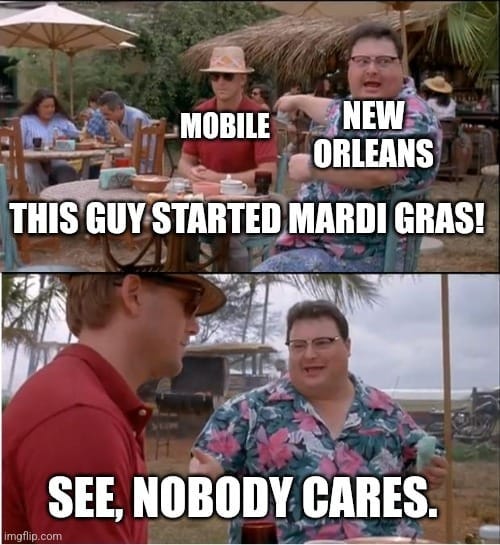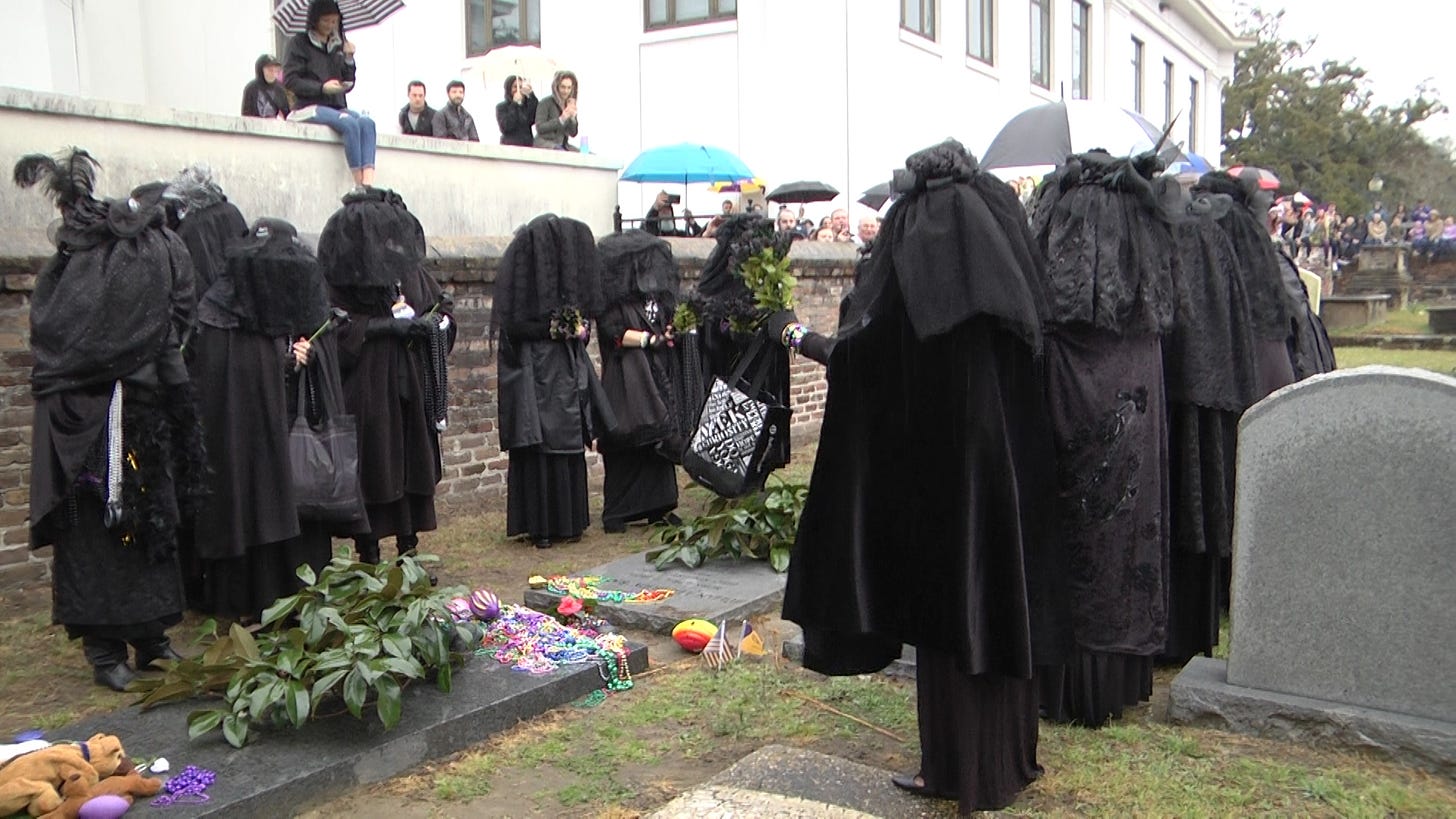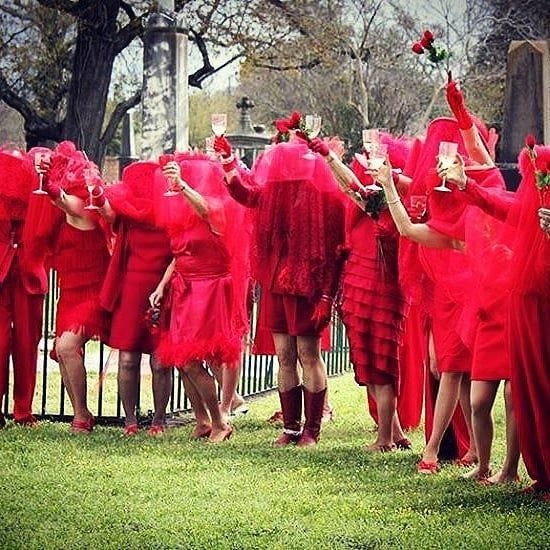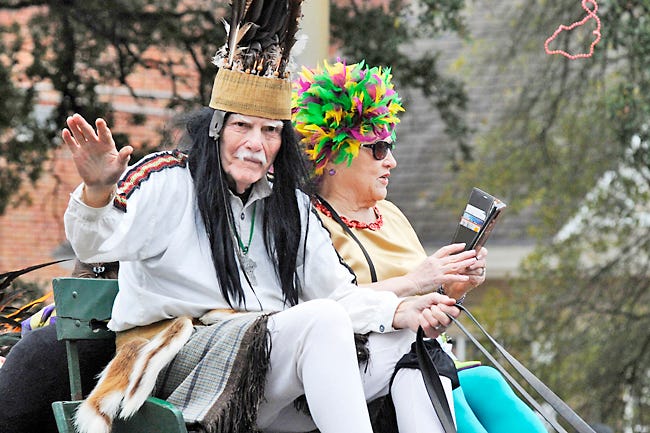The Pawnee Mural of Mobile's Mardi Gras
In the wonderful comedy series/gift to humanity, Parks and Recreation, which takes place at the offices of the Pawnee city government in Indiana, there are ongoing references to the murals painted in city hall – sometimes the main character Leslie refers to an historical event depicted in one of the murals, or sometimes newcomers are startled to see grisly and fanatical scenes painted in bright colors, displayed both with pride and as matters of fact.
Now not long after I moved to Mobile, I discovered the pervasive and treasured traditions surrounding Mardi Gras and the whole Mardi Gras season. Christmas décor is quickly replaced by Mardi Gras (including converting Christmas trees to Mardi Gras trees), king cakes and king-cake flavored and themed treats and merch are everywhere (there’s even a king cake-off I hope to attend at some point), and the dozens of Mardi Gras “societies” and “krewes” host their many balls and parades for the weeks leading up to “Deep Gras” - the last week and a half or so before Mardi Gras – a day when many schools/universities, services and businesses are shut.
Mobilians never tire of reminding the world that Mobile is the actual “birthplace of Mardi Gras”, instead of neighboring New Orleans famous for its festivities. It could more accurately be described as the birthplace of masked parades/balls, since the original Mobile parades, organized by French settlers when Mobile was the capital of French Louisiana, took place at New Years and not at Mardi Gras.
The history of Mardi Gras in Mobile is extremely rich, fraught, and more than I could summarize in a blog post (but there’s a fantastic documentary on this, and particularly the racial divides in Mobile’s Mardi Gras traditions, called Order of Myths - which is streaming on Netflix). One of the key “founding fathers” of the contemporary practices surrounding Mardi Gras is the local icon Joe Cain. As the local unofficial czar of Mardi Gras festivities “Mr. Mask” writes on the Mobile Mask website, “Joe Cain is viewed as the patron saint of Mobile Mardi Gras. As such, the city has built a truly unique and beloved celebration around him.” And as Joe Cain’s gravestone proclaims, “Here Lies Old Joe Cain, the Heart and Soul of Mardi Gras in Mobile.” “Joe Cain Day” includes what’s known as the “People’s Parade” because those participating don’t have to be in a Mardi Gras society and don’t have to pay to participate.

It is always the Sunday before Mardi Gras, and it includes elaborate rituals such as the “Merry Widows”, who shroud themselves in black in a theatric processional to mourn at Joe Cain’s grave,
and then a different group appears, shrouded in red, called the “Mistresses of Joe Cain”.
Year round, Mobile has a Joe Cain Café, a bar called the Merry Widow, a statue of Chief Slac in downtown’s Mardi Gras Park, and there’s a popular pub that hosts a “Half Way to Joe Cain Day” party in summers (sidenote: the article headline on that link highlights a nickname for Mardi Gras that makes my skin crawl: “Boom Boom”).
As a new Mobilian, I easily picked up on the fact that there was Joe Cain hype. So in my curiosity I looked up who Joe Cain is and what it’s all about. And it is basically a Pawnee city hall mural.
Here are the basic facts of Joe Cain: he was a Confederate veteran who was part of (founder of?) a group called the LOST CAUSE MINSTRELS. “Lost Cause” is the term, derived from a book title, for the “righteousness” of the Confederacy’s fight for “freedom” from the United States, and while “admirable”, was not to be (heavy emphasis on the air quotes here!). Minstrels were comic performers usually stereotyping Blacks and/or performing in blackface. The “L.C. Minstrels” changed Mobile history when one Fat Tuesday (probably in 1868 but some traditions maintain 1866), Joe Cain led their parade of celebratory music and mockery through downtown Mobile. Joe Cain paraded as a character he created named “Chief Slacabamorinico” (Chief Slac for short), a fictional chief of the very much not fictional Chickasaw Indians (native to the territory now Southeast U.S.). The display was part Fat Tuesday festivity, and part to irritate Union troops still occupying Mobile.
Joe Cain died in 1904 in Bayou la Batre not too far from Mobile, and his parades ended with his life. But in 1966 a Mobilian artist, journalist, and folklorist Julian Lee Rayford wanted to highlight Joe Cain’s contribution to Mobile history and organized the reinterment of his remains from Bayou la Batre to Mobile. Rayford sought to make Mardi Gras parading “more inclusive” than the existing secretive societies at the time, and from that point on, Joe Cain Day was born. Several men have served terms as the image of Chief Slac to lead the parade each year and appear at events.
It’s probably clear by now that I probably couldn’t Mardi Grinch any harder about Joe Cain Day. To be fair, most people celebrating Joe Cain probably wouldn’t support his actual positions, and I wouldn’t want anyone to read this post and think that Joe Cain Day is a rally for the Lost Cause and white supremacy - because on its surface it absolutely isn’t (I’d wager that Joe Cain participants are way more progressive than the actual Mardi Gras societies, at least the white ones – yes they are still racially segregated, again I recommend the film Order of Myths). The irrelevance of the original life of Joe Cain to the current experience of Joe Cain is almost exactly why it feels so ominous to me – like an annual reminder of a bundle of injustices so deep-seated that it can pass as fodder for “a truly unique and beloved celebration”. Someday someone should paint a mural of the big party that was the Lost Cause Minstrels and their leader dressed as a fake Indian chief to mock United States soldiers enforcing the end of slavery while recently freed Blacks navigated a deeply racist society without full citizenship?? I definitely think it could qualify for Pawnee City Hall.








